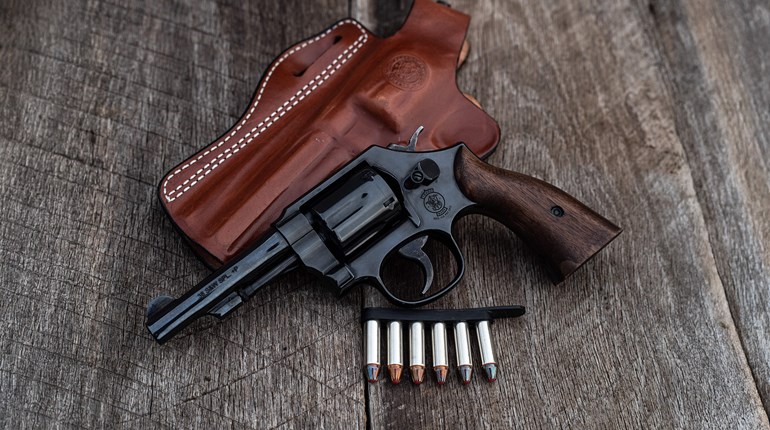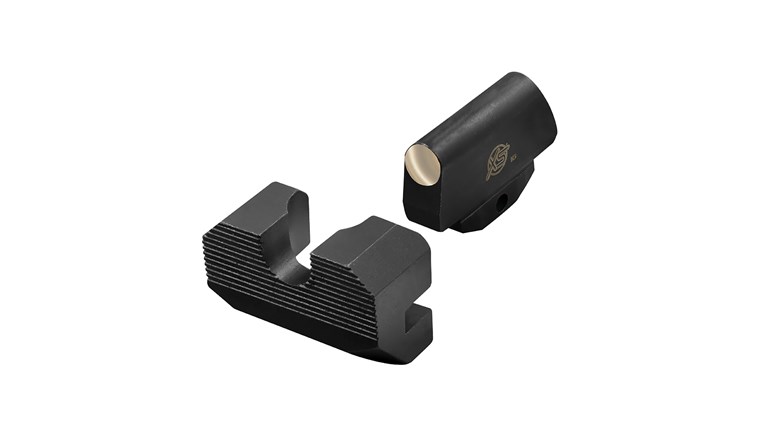
User-customizable barrel lengths, a choice of front-sight heights and a variety of chamberings placed Dan Wesson revolvers ahead of their time.
The big revolver had a reassuring, muzzle-heavy heft. For long-range work with a wheelgun, you need a lot of barrel. It gives you greater sight radius for distant targets, as well as more bore for slow-burning powders to work their magic, pushing heavy slugs a-way-out-yonder. This particular arm had 8 full inches of precision-rifled barrel ahead of a unique cylinder and lockwork mechanism.
There was a clean, business-like air about the gun, which was not calculated to sell on the basis of a polished-blue finish or precisely executed grip checkering. It was a shooter, pure and simple—designed and manufactured to fire thousands and thousands of accurate shots in a long service life.
This was the Dan Wesson revolver and the one I was shooting that long-ago day was chambered in a then-new and now-forgotten .375 Super Mag. Unfortunately, it isn’t just the caliber that’s coming up on obsolescence. The fine Dan Wesson revolvers are no longer competing for a portion of the shrinking revolver market.
That is a sorrowful thing in its own right. Dan Wesson was a 20th century gun designer and production executive who pretty well came into his own at the Massachusetts plant of Smith & Wesson. The name is not a coincidence, Wesson was a direct lineal descendant of Daniel B. Wesson, co-founder of the legendary gun maker. After leaving Smith & Wesson in the 1960s to found a company with his own name, Dan Wesson introduced a DA/SA revolver with many new features, including one that’s near-universally misunderstood.
Dan Wesson revolvers evolved through several generations of improvements and management. In the 1990s, the IHMSA (International Handgun Metallic Silhouette Association) discovered the Dan Wessons in big calibers to be ideal for their sport. Yet, another Wesson (Seth) was at the helm then and he was open to all kinds of innovation. The product was a modern DA/SA revolver in several sizes.
The wheelgun’s lockwork was modern, easy to manufacture and not derived from a mechanism of the late 19th century. It was also susceptible to judicious gunsmithing that can produce a fine match-grade trigger pull, particularly in single action.
Take a look at the innovations of the Dan Wesson revolver. At the back end, the butt section is quite different. There is a single strut extending down from the frame on which the mainspring is mounted. Since it is cylindrical in shape, it is easy to inlet for a one-piece grip.
At one point, the company even offered pre-inletted walnut blanks. These permitted the buyer to break out his Dremel tool and carve his own grip. He could also change his front sight with no more than an Allen wrench, which permitted a choice of front-sight heights and colors.
However, it is the barrel system that gives the Dan Wesson its unique nature. For a time, the company offered the gun in a kit, with several different barrels of different lengths. You could, for example, take off the general-purpose 4-inch system and replace with a 10-inch hunting rig, complete with a barrel-mounted scope. They appealed to the cost-conscious cop with a 2-inch snubby barrel for off-duty concealed carry and a 4- or 6-inch tube for uniformed use.
Seeing as how you could also change the grip, it was possible to use a single Dan Wesson frame and cylinder to give the gun sort of an all-guns-to-all-people character. I am sure the company sold a lot of guns to police officers on the basis of this swap-barrel-kit arrangement, but I am equally sure that it was not widely used. The swap could be accomplished with pretty respectable speed, but it was still just too much of a hassle for daily use.
However, another class of shooter found the Dan Wesson to be just the ticket for their sport. Silhouette shooters engaged banks of five animal outlines (chickens, pigs, turkeys, rams) at distance (50, 100, 150 and 200 meters, respectively). Cut from heavy steel plate, each target had a narrow foot and would not easily fall over.
Magnum revolvers were the order of the day, as it took power to drop the 54-pound ram at 200 meters, etc. These shooters learned more about handgun performance than was ever before known and had some great weekend matches. But, they needed accuracy to match all that power. They got it with the Dan Wesson.
Developed by engineer Karl Lewis, the Dan Wesson barrel was a three-piece system that produced superior accuracy. Mounted on the front face of a typical revolver frame, there was a barrel, barrel shroud and barrel nut. Beginning with a frame and cylinder, the handgunner screws the barrel—threaded on both ends—into the frame. He tightens the rear of the barrel against the face of the revolver cylinder with a provided .006-inch feeler gauge.
This establishes the critical barrel-cylinder gap. Then he slips the barrel shroud over the barrel, ensuring the positioning pin on the front of the frame fits into the hole in the rear surface of the shroud. It is that same shroud that gives the business end of the gun its distinctive contour with underlug, sighting rib and graceful look. The last step is to screw the barrel nut onto the threaded front end of the barrel (actually into the shroud) and tighten it down with a special wrench.
In this way, the barrel is held firmly at the rear where it is screwed into the frame. At the muzzle end, the rearmost edge of the barrel nut encounters a ledge in the shroud, which has the effect of pulling the barrel forward. This literally puts the barrel in traction and controls the vibration and twisting. It has a measurable effect on accuracy.
Unfortunately, a higher level of accuracy in a revolver was not a feature in high demand in the police world of the 1970s and 1980s. Dan Wessons earned respect and their reasonable pricing puts many of them in sportsmen’s kits. I personally knew only one law enforcement officer who used one of these fine revolvers as his chosen fightin’ iron.




































